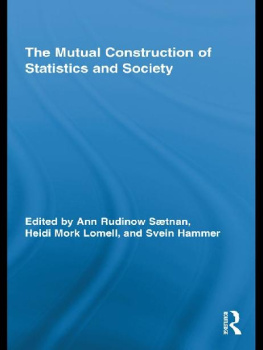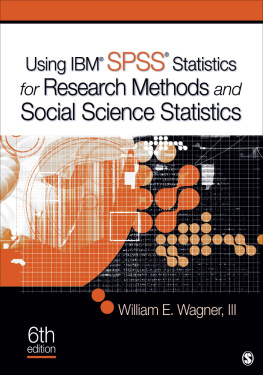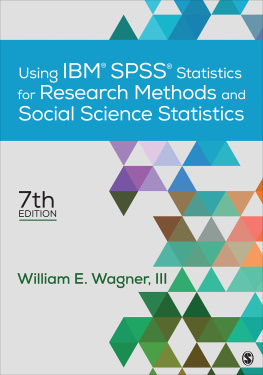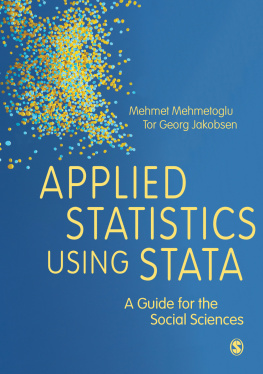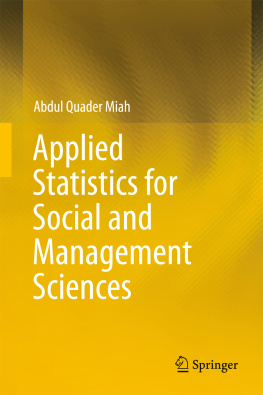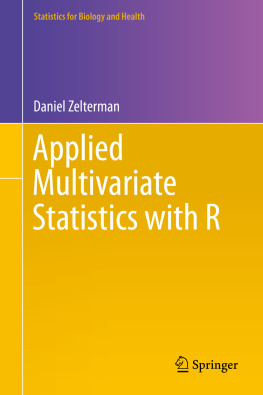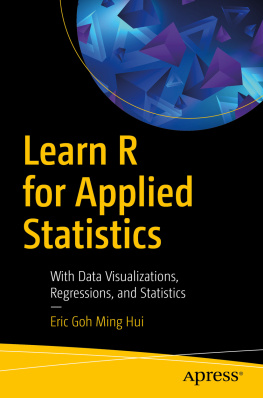The Mutual Construction of Statistics and Society
Routledge Advances in Research Methods
1. E-Research
Transformation in Scholarly Practice
Edited by Nicholas W. Jankowski
2. The Mutual Construction of Statistics and Society
Edited by Ann Rudinow Stnan, Heidi Mork Lomell, and Svein Hammer
The Mutual Construction of Statistics and Society
Edited by Ann Rudinow Stnan, Heidi Mork Lomell, and Svein Hammer
New York London
First published 2011
by Routledge
270 Madison Avenue, New York, NY 10016
Simultaneously published in the UK
by Routledge
2 Park Square, Milton Park, Abingdon, Oxon OX14 4RN
Routledge is an imprint of the Taylor & Francis Group, an informa business
This edition published in the Taylor & Francis e-Library, 2010.
To purchase your own copy of this or any of Taylor & Francis or Routledges collection of thousands of eBooks please go to www.eBookstore.tandf.co.uk.
2011 Taylor & Francis
The right of Ann Rudinow Stnan, Heidi Mork Lomell and Svein Hammer to be identified as the authors of the editorial material, and of the authors for their individual chapters, has been asserted by them in accordance with sections 77 and 78 of the Copyright,
Designs and Patents Act 1988.
All rights reserved. No part of this book may be reprinted or reproduced or utilised
in any form or by any electronic, mechanical, or other means, now known or hereafter invented, including photocopying and recording, or in any information storage or
retrieval system, without permission in writing from the publishers.
Trademark Notice: Product or corporate names may be trademarks or registered trademarks, and are used only for identification and explanation without intent to infringe.
Library of Congress Cataloging-in-Publication Data
The mutual construction of statistics and society / edited by Ann Rudinow Stnan,
Heidi Mork Lomell, and Svein Hammer. 1st ed.
p. cm. (Routledge advances in research methods ; v. 2)
Includes bibliographical references and index.
1. Statistics. 2. Public administration. I. Saetnan, Ann Rudinow. II. Lomell,
Heidi Mork. III. Hammer, Svein.
HA29.M88 2010
001.4'33dc22
2010004307
ISBN 0-203-84661-3 Master e-book ISBN
ISBN13: 978-0-415-87370-3 (hbk)
ISBN13: 978-0-203-84661-2 (ebk)
Contents
ANN RUDINOW STNAN, HEIDI MORK LOMELL AND SVEIN HAMMER |
JON HOVLAND |
ALAIN DESROSIRES |
CHRISTOPHER KULLENBERG |
SVEIN HAMMER |
ELLEN BALKA AND KJETIL RODJE |
LUISA FARAH SCHWARTZMAN |
ASUNCIN LERA ST. CLAIR |
CHRIS WILLIAMS |
ELLEN BALKA |
HEIDI MORK LOMELL |
SVEIN HAMMER AND SIGRUNN TVEDTEN |
SONJA JERAK-ZUIDERENT AND ROLAND BAL |
GUNHILD TNDEL |
HELENE I. GUNDHUS |
Figures
| 1.1 | OLS regression from TBU (2005: 58), municipal income and production. |
| 3.1 | Survey forms, postcards, and telephone calls are assembled as programs of action. |
| 4.1 | An analytical framework for studies of governmentalities. |
| 9.1 | The multiple domains of electronic triage. |
| 12.1 | Working document of quality management team for collecting the data on performance indicators requested by the Health Inspectorate. |
Tables
| 2.1 | The State, the Market and Statistics |
| 2.2 | Poverty in England at the End of the Ninteenth Century: Three Policies and Their (Three) Instruments |
| 6.1 | Classification for Quota Purposes as % of Classification in Socioeconomic Questionnaire |
| 8.1 | Identifications from the Register, 18701873 |
| 13.1 | Physicians Strategies and Their Characteristics |
Acknowledgments
Just as our galley proofs for this book arrived, so too did the news of Susan Leigh Stars untimely death. Leigh was a major source of inspiration for this book. The book consists almost exclusively of articles developed from papers first delivered at the workshop Statistics as a Boundary Object between Science and the State, already the title reflecting our indebtedness to Leigh. Leigh graciously agreed to attend the workshop, where she not only made a keynote lecture reclaiming her boundary object concept from the interpretative drift it had been subjected to over time, but also attended paper presentation sessions, contributing encouraging and constructive comments. We had hoped she might review the book, reclaiming again her concept form any misinterpretations we might have perpetrated. We were hoping soon to see a book of her own, elaborating the boundary object concept. Instead, with both sorrow and gratitude, we dedicate this book to Leigh.
While some authors have further acknowledgments relevant to their respective chapters, we wish here to add a few more acknowledgments to individuals and institutions that contributed to the project and the book as a whole. First of all, thanks to the Norwegian Research Council (NFR) and to the Norwegian University of Science and Technology (NTNU). Together they funded the projects For Whom the Bell Curves and Health by Numbers.
Besides providing research funding to many of the contributors to this volume (Ann Rudinow Stnan as head of the projects; Heidi Mork Lomell and Svein Hammer as post-doctoral fellows; Jon Hovland, Luisa Farah Schwartzman, and Gunhild Tndel as PhD fellows), the projects also funded the aforementioned workshop where most of the chapters in this volume (and many not included here, but reflected indirectly as sources of inspiration) were first presented and discussed. Thanks go also to the European Association for the Study of Science and Technology (EASST) which provided funding for graduate student travel grants to the workshop. And warm thanks to all the workshop participants for constructive contributions, both of other papers and of comments on those included here.
Last but not least, thanks to editors, anonymous referees, and others in the long list of production functions we have encountered and learned from through the publishing process at Routledge. The book is the better for your help!
Introduction
By the Very Act of CountingThe Mutual Construction of Statistics and Society
Ann Rudinow Stnan, Heidi Mork Lomell, and Svein Hammer
How does the act of counting affect the world? How does it change the objects counted, change the lives of those who count (double entendre intended)? Some say that only whats counted counts (Waring 1989, Anderson and Fienberg 1999). Others (purportedly Albert Einstein among them) say the opposite: Not everything that can be counted counts, and not everything that counts can be counted (The Quotations Page). Our argument, briefly stated, is that society and the statistics that measure and describe it are mutually constructed . This argument addresses two counterarguments from seemingly opposite directions. On the one hand, we oppose the notion that statistics are simple, straightforward, objective descriptions of society, gathered from nonparticipant points of observation. We claim, and demonstrate, that in the act of counting we do not stand neutrally outside the object we count, but rather (to some extent) enter into it, redefine it, change the stakes that affect it, and thus even change the numbers we count to represent it. This is not only because all knowledge is produced from some position or other with a partial and fragmentary view of the world, not only because the so-called god trick (Haraway 1991: 191)the trick of being all-seeing, as from a point both everywhere and nowhereis a dangerous illusion, but also because the very act of counting is a specific form of viewing. Like all other specific forms of viewing, it is a social act. Counting acts in and upon the social world. Of course, this also means that not counting has an effect on the aspects of the world we (do and/or dont) count. What we choose to count, what we choose not to count, who does the counting, and the categories and values we choose to apply when counting are matters that matter (see, e.g., Anderson and Fienberg 1999, Waring 1989). Thus users (producers, readers, interpreters, deployers) of statistics are users that matter (Oudshoorn and Pinch 2003).

